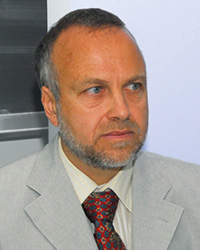Claudio Nidasio interviews Renato Lo Cigno.
The topic of intelligent cars, already part of everyday life, offers great scope for improvement with innovations that in the next few years will move out of research laboratories and onto the market. We discussed this technology with Renato Lo Cigno, a professor in the University’s Department of Information Engineering and Computer Science (DISI) and coordinator of the research group Advanced Networks Systems (ANS).
Professor Lo Cigno, what is collaborative driving and which industrial groups are involved in it?
 Collaborative driving aims to make vehicles communicate with each other, to avoid accidents, improve traffic flow and free drivers from some tasks, for example by forming a “platoon” of cars in which only the first vehicle is driving autonomously and the others follow. All of the major vehicle manufacturers are investing in this area, from Toyota to Volvo, from General Motors to BMW, Mercedes, Volkswagen, Scania and Honda. “Autonomous” vehicles like Google Car will be able to collaborate with each other and we hope also with other road users.
Collaborative driving aims to make vehicles communicate with each other, to avoid accidents, improve traffic flow and free drivers from some tasks, for example by forming a “platoon” of cars in which only the first vehicle is driving autonomously and the others follow. All of the major vehicle manufacturers are investing in this area, from Toyota to Volvo, from General Motors to BMW, Mercedes, Volkswagen, Scania and Honda. “Autonomous” vehicles like Google Car will be able to collaborate with each other and we hope also with other road users.
What technologies and solutions are your research group studying?
We are working on techniques for communication between vehicles, and protocols and algorithms for coordinating them. The communication is via radio and direct (not through the cellular network) to minimize delays and to avoid interference from other communications. As far as applications are concerned, we are working on emergency braking, control of platoons, and coordination to avoid collision at intersections, where most casualties occur.
We have also recently become some of the first in the world to start working on the possibility of communication with the so-called weak road users, pedestrians and cyclists. We are studying the dynamics of the classic situations in which a bicycle has right of way over a vehicle, but for some reason (such as lack of visibility) the vehicle does not give way. Here it is necessary to study all the possible trajectories and how the two systems could warn the rider or driver (or both) or intervene autonomously by taking control of the vehicle.
Do you think that in addition to the technology this will also require changes in society and in the law?
The conditions need to be created in which people can accept the idea that vehicles are autonomous or semi-autonomous, but the well-publicised Google Car will pave the way here. In addition, this innovation needs to be facilitated by legislators. Traffic laws need to be updated to include these technologies, for example by changing the definition of safe following distance, as two coordinated vehicles can be much closer, saving fuel.
What solutions will we see on the roads in the near future for the transport of people and goods?
I think we will start to see heavy vehicles that have double or triple trailers forming a platoon on the motorway. Another application that we will see is braking assistance that works much better than radar assisted braking. We will also have driver alert systems, for example when two cars that are communicating with each other predict that there is a high probability of an accident at an intersection.




